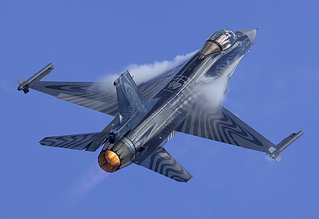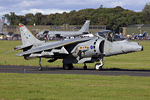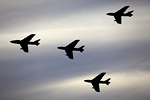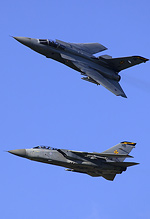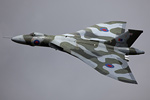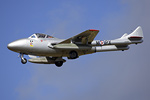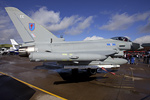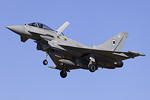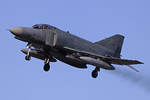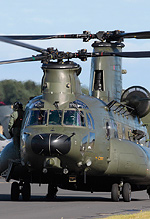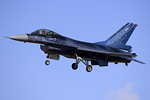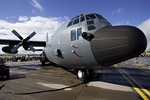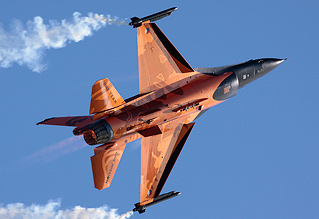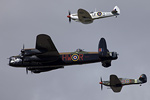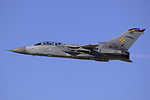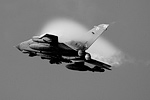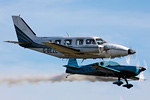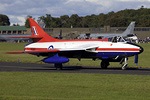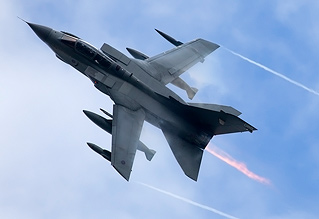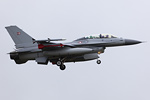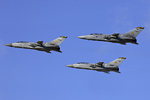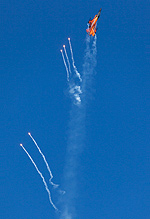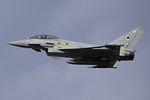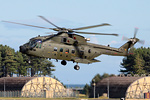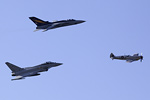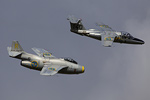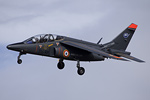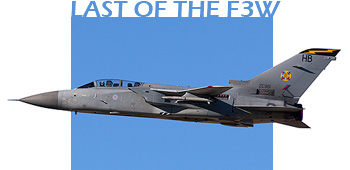
RAF Leuchars International Airshow Report
Saturday 11th September 2010
Air Defence: Past, Present and Future was very much the theme for Leuchars' 2010 airshow, a show that was unique for being a remembering, a beginning and an ending. Alongside its annual role as a Battle of Britain at Home Day in memory of the 1940's air battle this year's show also displayed Leuchars' future with the first public showing of the newly formed and Typhoon-equipped 6 Squadron. However, for most the show would be recalled for being one thing - the final UK display of the Tornado F3; 'Last Show of the Last Interceptor'.
reports from Leuchars. Additional photography by .
The lineage of air defence was featured in the flying display from the get-go as just two acts in Spitfire, Tornado and Typhoon joined in a special formation as 6 Sqn displayed their 'reporting for duty' with a parade for the Chief of the Air Staff in front of the old control tower. With this historic moment marked it was time for the flying to start proper. Current military participation was standard Leuchars fare although the Dutch F-16 did carry a bit more 'wow factor' than usual with dispensation to use its flares and the French Alphajet showed that trainers can put on a decent display with its dirty roll on take-off and a high-alpha pass that is surprisingly impressive sight from a relatively low-powered aircraft.
Despite the loss of the Scandanavian Historic Flight's A-26B Invader and P-51 Mustang, warbirds were well represented with the Historic Aircraft Company's Spitfire and Hurricane as well as the Battle of Britain Memorial Flight who made it up with their silver Spitfire Mk IX, Hurricane MkII 'Last of the Many' and the venerable Lancaster.
Social media had been embraced with gusto by the organisers with updates on the planning and construction of the airshow posted in the run-up. These updates continued throughout the show day with regular posts on Facebook and Twitter on what was next to take to the skies and the latest traffic information. The new traffic plan which saw a shift from on-base parking to a more Park-and-Ride based solution seemed to trade difficulty leaving the show for both difficulty leaving and getting there. Park-and-Ride buses from the west appeared not to have a dedicated route and were instead left sitting idle in traffic. From getting on a bus to being dropped off was easily a 45minute to an hour journey for those that would stick it out, it was in fact faster to omit the buses and walk the two miles to the main gate. Leaving the Park-and-Ride was to be equally frustrating with a minuscule 100 metres to the exit quite easily taking 1.5hrs thanks to a complete lack of coordination and communication - until RAF personnel appeared that was. With so many people leaving at the same time it is perhaps unavoidable but delaying the shutting of the base to the public would help, a couple of hours after the end of the flying programme would decrease the density of departing traffic somewhat and allow for a more relaxed ending to the show - the public would no longer feel that their presence is an inconvenience.
Those looking for some classic jet action were spoiled for choice with the world's oldest flying jet, F-86A Sabre G-SABR, the Norwegian Air Force Historic Flight's Vampire T55 alongside the J29 Tunnan and SK60 of their Swedish counterparts - the 'Barrell' being a major highlight in the flying programme. Team Viper debuted their new all-Hunter display at the show and whilst it may not have been as tight as the previous Strikemaster incarnation the sight of four Hunters in the air, not to mention the noise when including a 'blue noter', made up for it. Brake gremlins sorted a certain V-bomber made it up too.
The presentation of the static display has always been a perennial bugbear at Leuchars so the announcement in the run up to the show that a "critical look at our approach to barriers" had been taken was a welcome one especially as this carried a belief that "photo opportunities will be better". Unfortunately this hope never really translated into reality, the ropes strung between the barriers were indeed less intrusive but they were few and far between and being so close to the static aircraft meant little had changed. That said this change did demonstrate a desire to improve and with a little refinement - more rope and less barrier - an acceptable compromise could be found.
Of course the type of perimeter between the aircraft and the public is only half the problem and once again aircraft were crammed together, misaligned, with wings overlapping and pitot probes practically hanging over barriers. This apparent lack of thought in the placement of the static was further demonstrated with the 6 Sqn Typhoon, its first public appearance at its new base should have seen it given pride of place only equalled by the resident 111[F] Sqn F3s but instead it was honoured by having an ice-cream van parked all but inside it. The Tremblers saw their presence in the static doubled compared to the previous year but this was with one aircraft parked in the flying aircraft park next to one of the 6 Sqn Typhoons, an appropriate partnership but one that would have looked better as the centrepiece of the static. The other F3 - a Battle of Britain coded machine - sat on the cross runway at a public entrance serving as a 'Gate Guardian', a nice touch which unfortunately saw it sitting out a long way away from the actual static display or displays as there was a vast expanse on either side of the cross-runway - devoid of aircraft and only sparsely populated by traders. It was a shame that with one of the smallest static displays for some 15 years, so much spare space appeared available in the centre of the airfield whilst the few aircraft there were could be found packed so tight that even sardines would feel sorry for them.
However, on the day that would be the only real fault you could level against the show. The souvenir programme was very reasonably priced at £5 and its production values put the corporate machine of RIAT to shame. The flying display was strong with a mixture of both current and past military types as well as a healthy number of warbirds to celebrate the 70th anniversary of the Battle of Britain. The static, while it may not have been presented as well as it could have, had some notable highlights; for the first time in eight years a VC-10 was in attendance, even rarer than an RAF Hercules was the French example basking in the sun and the Chinook turned out to be of the HC3 variety, another airshow debutante. But more important than all of this was the fact that after over two decades of service the Tornado F3 was afforded a send-off that just months prior to the show looked doubtful.
Just as the F3 was involved in the first act of the show so it was in the finale. A trio of Tremblers took off followed by a singleton, ZE961 - an aircraft whose participation was particularly poignant. A 4-ship 'Diamond' pass was followed by a 3-ship 'Vic' and then from the North Sea came F3 ZE961 accompanied by a 'Flying Can Opener'. Motoring in with vapour in tow the Leuchars duo carried out the F3's final Sunset Ceremony with Typhoon carrying on straight and true and Tornado shooting heavenwards in a bitter-sweet moment marking the end of one era and the beginning of another. A run-and-break later and the aircraft had been recovered, the last of which was ZE961 - the first F3 to land at Leuchars back in 1989 when 43[F] Sqn arrived at the airshow and now 21 years later the last down in the types public farewell, the finishing touch of which saw the Tremblers backtrack down the runway in front of the crowd to their HAS site.
The 2010 show saw Leuchars welcome 6 Sqn to their new base perhaps next year the airshow will do the same for the second coming of 43[F] Sqn, the return of the 'Fighting Cocks'.

